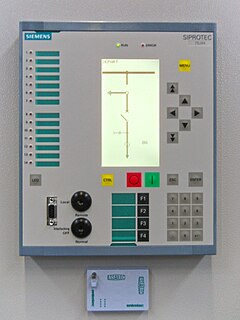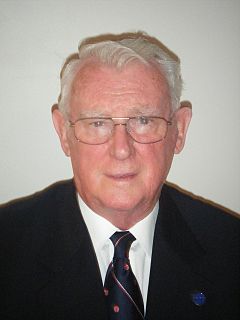
Electric power distribution is the final stage in the delivery of electric power; it carries electricity from the transmission system to individual consumers. Distribution substations connect to the transmission system and lower the transmission voltage to medium voltage ranging between 2 kV and 35 kV with the use of transformers. Primary distribution lines carry this medium voltage power to distribution transformers located near the customer's premises. Distribution transformers again lower the voltage to the utilization voltage used by lighting, industrial equipment or household appliances. Often several customers are supplied from one transformer through secondary distribution lines. Commercial and residential customers are connected to the secondary distribution lines through service drops. Customers demanding a much larger amount of power may be connected directly to the primary distribution level or the subtransmission level.

The electric power industry covers the generation, transmission, distribution and sale of electric power to the general public and industry. The commercial distribution of electric power started in 1882 when electricity was produced for electric lighting. In the 1880s and 1890s, growing economic and safety concerns lead to the regulation of the industry. What was once an expensive novelty limited to the most densely populated areas, reliable and economical electric power has become an essential aspect for normal operation of all elements of developed economies.

William Stanley Jr. was an American physicist born in Brooklyn, New York. In his career, he obtained 129 patents covering a variety of electric devices. In 1913, he also patented an all-steel vacuum bottle, and formed the Stanley Bottle Company.

Power engineering, also called power systems engineering, is a subfield of electrical engineering that deals with the generation, transmission, distribution and utilization of electric power, and the electrical apparatus connected to such systems. Although much of the field is concerned with the problems of three-phase AC power – the standard for large-scale power transmission and distribution across the modern world – a significant fraction of the field is concerned with the conversion between AC and DC power and the development of specialized power systems such as those used in aircraft or for electric railway networks. Power engineering draws the majority of its theoretical base from electrical engineering.

John Roy Whinnery was an American electrical engineer and educator who worked in the fields of microwave theory and laser experimentation.

A smart grid is an electrical grid which includes a variety of operation and energy measures including smart meters, smart appliances, renewable energy resources, and energy efficient resources. Electronic power conditioning and control of the production and distribution of electricity are important aspects of the smart grid.
Jean-Jacques Archambault was a Quebec engineer. He worked at Hydro-Québec and is known for his work on the 735kV electric transmission technology in the early 1960s.

In utility and industrial electric power transmission and distribution systems, a numerical relay is a computer-based system with software-based protection algorithms for the detection of electrical faults. Such relays are also termed as microprocessor type protective relays. They are functional replacements for electro-mechanical protective relays and may include many protection functions in one unit, as well as providing metering, communication, and self-test functions.
Arun Phadke is a University Distinguished Research Professor in the Department of Electrical and Computer Engineering at Virginia Tech. Along with fellow Virginia Tech professor James Thorp, Dr. Phadke received The Franklin Institute's 2008 Benjamin Franklin Medal in Electrical Engineering for their contributions to the power industry, particularly microprocessor controllers and Phasor measurement unit (PMU) technology in electric power systems.

An electrical grid, electric grid or power grid, is an interconnected network for delivering electricity from producers to consumers. It consists of:
Arnaldo Maria Angelini (1909–1999) was an Italian engineer and Professor of Electrotechnics at the Sapienza University of Rome, known for contributions in the development of nuclear generating stations as well as hydro and pumped hydro stations, and the improvement of Italy's transmission and distribution systems.
The IEEE Power & Energy Society, formerly the IEEE Power Engineering Society, is the oldest society of the Institute of Electrical and Electronics Engineers (IEEE) focused on the scientific and engineering knowledge about electric power and energy.
The IEEE Medal in Power Engineering was created by the Board of Directors of the Institute of Electrical and Electronics Engineers (IEEE) in 2008, and presented for the first time in 2010. This award is given to an individual with outstanding contributions in power engineering. The official more extended version is: "for outstanding contributions to the technology associated with the generation, transmission, distribution, application, and utilization of electric power for the betterment of society".
The IEEE Herman Halperin Electric Transmission and Distribution Award is a Technical Field Award of the IEEE that is presented for outstanding contributions to electric transmission and distribution. The award may be presented annually to an individual or a team of up to three people. It was instituted by the IEEE Board of Directors in 1986.
The IEEE Richard Harold Kaufmann Award is a Technical Field Award of the IEEE that was established by the IEEE Board of Directors in 1986. This award is presented for outstanding contributions in industrial systems engineering.
Carlos Katz is an American electrical engineer, researcher and the recipient of the 2010 IEEE award. His area of research is the properties and methods of manufacture of extruded and laminar dielectric high voltage power cables, and extension of service life of installed cables. He has written papers about the effects of water treeing on the life of cable installations.

Roy Billinton is a Canadian scholar and a Distinguished Emeritus Professor at the University of Saskatchewan, Saskatoon, Saskatchewan, Canada. In 2008, Billinton won the IEEE Canada Electric Power Medal for his research and application of reliability concepts in electric power system. In 2007, Billinton was elected a Foreign Associate of the United States National Academy of Engineering for “contributions to teaching, research and application of reliability engineering in electric power generation, transmission, and distribution systems."
Daniel Douglas Sabin from Danvers, Massachusetts, USA was named Fellow of the Institute of Electrical and Electronics Engineers (IEEE) in 2016 for leadership in power quality database management and analysis software. He was a principal engineer with Electrotek Concepts when he was elevated to Fellow.








